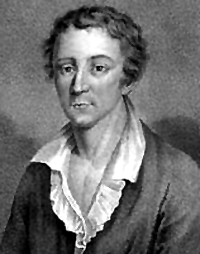Ippolit Bogdanovich facts for kids
Quick facts for kids
|
|
|---|---|
 |
|
| Born | December 23, 1743 Perevolochna, Poltava Regiment, Cossack Hetmanate |
| Died | January 6, 1803 (aged 59) Kursk, Kursk Governorate, Russian Empire |
| Occupation | Poet, editor |
| Alma mater | Imperial Moscow University (1763) |
| Literary movement | Rococo |
| Notable works | poem Dushenka |
Ippolit Fyodorovich Bogdanovich (born December 23, 1743 – died January 6, 1803) was a famous Russian writer. He was known for his light and playful poems. Bogdanovich was part of the classicist and rococo art movements.
His most famous work is a long poem called Dushenka, which came out in 1778.
The Life of Ippolit Bogdanovich
Ippolit Bogdanovich came from a noble family in Ukraine. He studied at Moscow University until 1761. His writing career began two years later. He started by editing a literary magazine.
In 1766, he worked as a secretary at the Russian embassy in Dresden. Three years later, he returned to Saint Petersburg. There, he edited the Vedomosti newspaper. This was the only official newspaper at the time. He worked there from 1775 to 1782.
In 1788, Bogdanovich became the Director of State Archives. This job was a sinecure, meaning it paid well but didn't require much work. This gave him lots of free time. He used this time to translate works by famous thinkers like Voltaire, Diderot, and Rousseau.
The Story of Dushenka
In 1778, Bogdanovich released his most famous work, Dushenka. This long poem was a bit like a mock epic. A mock epic is a long poem that uses the style of serious epic poems but for a funny or light topic.
Dushenka was a new version of La Fontaine's Psyche. The original story came from an ancient writer named Apuleius. Bogdanovich made it special by telling it like a Russian folk tale. The final version of the poem came out in 1783. It quickly became very popular. People loved its playful and slightly cheeky parts.
Bogdanovich described his main character, Dushenka, as "a living, modern girl from a gentry family." After Dushenka was published, Bogdanovich became known as Russia's best writer of light poetry. He joined the literary group of Princess Dashkova. Even Catherine II of Russia, the Empress, asked him to write plays for her Hermitage Theatre.
How Dushenka Influenced Others
By 1841, Bogdanovich's masterpiece, Dushenka, had been printed 15 times. Today, people remember it for two main reasons. First, there are the beautiful illustrations by Fyodor Petrovich Tolstoy. These drawings are in the Neoclassical style. Second, the poem is mentioned in works by the famous poet Pushkin, like Eugene Onegin.
Dushenka greatly influenced a young Pushkin. He read the poem a lot when he was a student at the Imperial Lyceum. Later, Pushkin thought Bogdanovich's early poems were not as good.
Vladimir Nabokov, another famous writer, described Dushenka well. He said its light and witty style hinted at Pushkin's early work. He also said it was an important step in the growth of Russian poetry. Its simple, everyday melodies also influenced Pushkin's teachers, like Nikolay Karamzin, Konstantin Batyushkov, and Vasily Zhukovsky.


